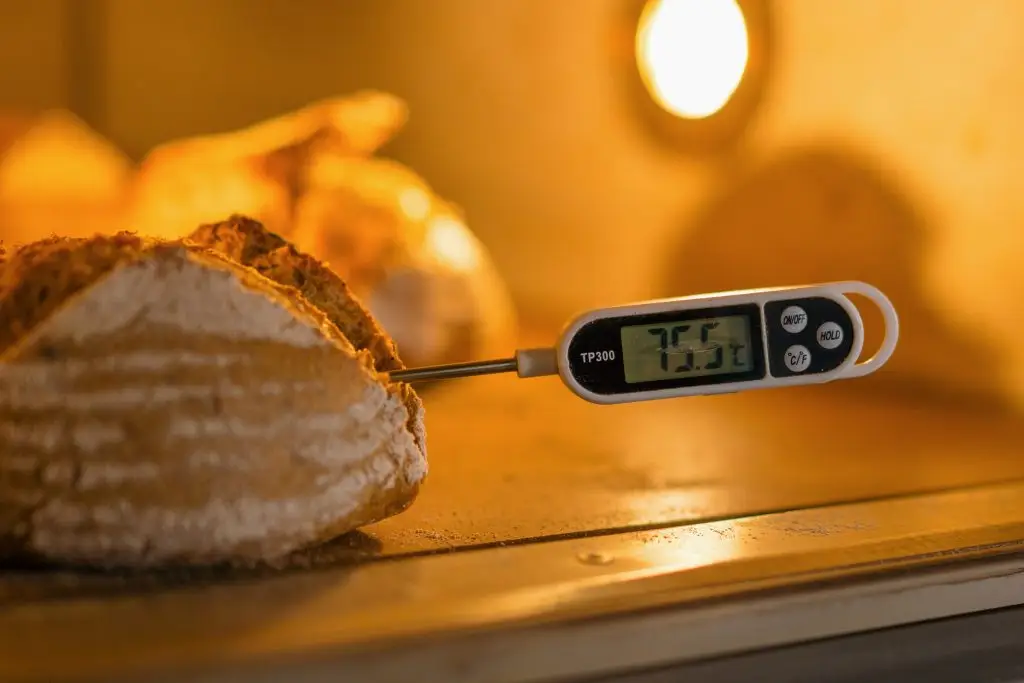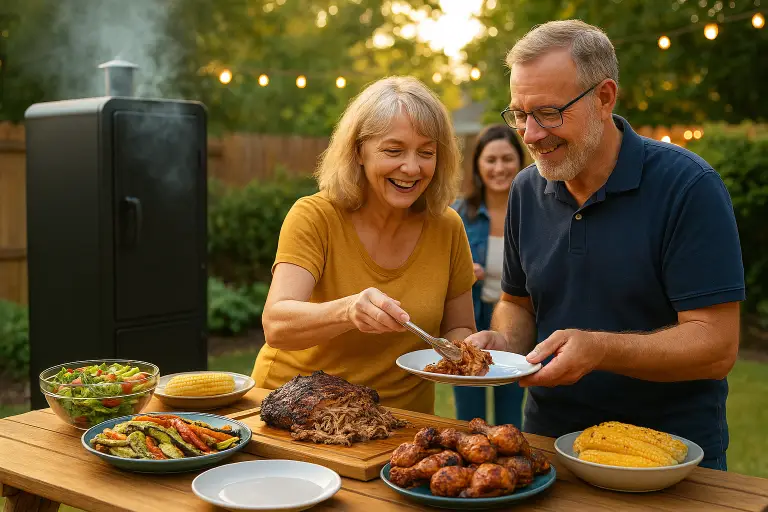Great BBQ isn’t just smoky—it’s safe and juicy. Here are the core temps that matter, how resting really works, and a few thermometer tricks that save the day—tailored for UK home smokers and grills.
Safe minimum temperatures (°C)
Use these as minimums for safety. For tough cuts (brisket, pork shoulder, short ribs) you’ll often cook beyond these to reach probe‑tender.
Poultry
- Chicken (whole/parts): 74°C minimum in the thickest part of breast or thigh (avoid bone).
- Turkey crown: 74°C minimum.
Pork
- Pork loin/steaks: 63°C, rest to ~65°C (juicy and safe).
- Pork shoulder (pulled): typically 95°C and probe‑tender.
- Pork ribs: 93–96°C and tender between the bones (skewer slides like butter).
Why pork isn’t chicken (UK context)
- Different risk profile: In poultry, Campylobacter/Salmonella can exist throughout the bird, so you must cook to 74°C (no resting shortcuts). For whole, intact pork cuts, bacteria are mostly on the surface, which is sterilised quickly by searing; the interior is effectively sterile.
- EU/UK Trichinella controls: Commercial UK/EU pork is controlled and tested under EU rules, making Trichinella in retail pork extremely rare.
- Modern guidance for whole cuts: For pork chops, loin and roasts you can cook to 63°C and rest (carryover takes it higher). This keeps pork juicy without compromising safety.
- But not for minced/rolled/stuffed: Sausages, mince, burgers, mechanically‑tenderised, injected or rolled joints should be treated like poultry: ≥71–74°C (or 70°C for 2 minutes) because surface bacteria can be mixed through the meat.
Beef
- Burgers/minced: 71°C (minced meat must be cooked through).
- Brisket (flat/pack): pull when probe‑tender—often 92–98°C.
- Short ribs: 95–98°C and jiggles like jelly.
- Steak (guide): rare 50, med‑rare 57, medium 63, well‑done 71. Always probe the thickest part.
Fish
- Salmon: 50–52°C for medium; firmer 54–56°C.
- Delicate fish (cod, haddock): 50–52°C; oily fish (mackerel): 52–55°C.
Label wording you can copy: Always probe food before eating to ensure it reaches at least X°C at the thickest point.
Resting makes it better
Resting allows juices to redistribute and fibres to relax—so slices stay moist.
- Brisket / pork shoulder: Vent for 5 mins (stop carryover), then rest 60–120 mins wrapped in a warm box/cooler.
- Short ribs: 30–60 mins wrapped.
- Ribs (pork): 10–15 mins.
- Chicken: 10–15 mins; keep the skin side up so it stays crisp.
- Salmon: 5 mins—don’t over‑hold or it will keep cooking.
Carryover cooking (what to allow)
- Large joints: +2 to +5°C after pulling.
- Thin cuts/steaks: +1 to +2°C.
Pull a little early if you’re targeting a specific doneness.
Thermometer tips (fast wins)
- Trust your probe, not the clock. Time is a guide; tenderness wins. Use the Planner to schedule, then verify with temperature and feel.
→ https://www.kitchensizzlers.com/bbq-smoker-time-calculator/ - Calibrate now and then: 0°C in ice slurry; ~100°C at full boil (adjust for altitude).
- Multiple spots: Check 2–3 places; aim for the centre of the thickest part, away from bone and big fat seams.
- Chicken legs: Probe near the joint but not on bone.
- Brisket: Probe across the grain in the flat; go for that warm‑butter slide.
- Don’t hit the tray or grate. Touching metal gives false highs.
Target temps + texture cheat‑sheet (by cut)
| Cut | Target (°C) | Texture cue |
|---|---|---|
| Chicken legs/thighs | 74+ | Clear juices; probe slides in easily near joint |
| Turkey crown | 74+ | Moist fibres, no red near bone |
| Pork loin | 63 (rest to ~65) | Slight blush in centre; juicy |
| Pork shoulder (pulled) | 95 (tender) | Probe‑tender; bone wiggles free |
| Pork ribs | 93–96 (tender) | Skewer between bones like butter; rack bends cleanly |
| Brisket | 92–98 (tender) | Probe glides with little resistance; jiggle |
| Beef short ribs | 95–98 | Jiggles; bone almost clean |
| Salmon | 50–52 (med) | Pearly flakes; still silky |
Common pitfalls (and fixes)
- Reading only one spot: Move the probe—cold centres hide in thick roasts.
- Chasing a number for brisket/ribs: Temp is a waypoint; tenderness decides.
- Dry chicken breasts: Pull at 63–65°C if you sous‑vide or pan‑finish; otherwise cook to 74°C and rest.
- Split fibres after slicing: Didn’t rest long enough—give big joints at least an hour.
- Over‑resting fish: Serve within 5–10 mins of pull.
Handy tools
- Planner: Build a step‑by‑step timeline with your smoker style, weight and wrap choices → https://www.kitchensizzlers.com/bbq-smoker-time-calculator/
- Kitchen Calculators (Brine + Yield): Work in grams, plan servings, and mix brines by percentage → https://www.kitchensizzlers.com/brine-calculator/
FAQs
Why is brisket “done” at different temps? Collagen converts at different rates; fat content and thickness vary. Pull when probe‑tender, typically 92–98°C.
Is pink chicken ever safe? Colour can mislead. If the thickest part reads ≥74°C, it’s safe.
Can I skip resting? You can—but expect drier slices. Resting is free juiciness.
Where should I insert the probe? Thickest point, centred, away from bone (bone conducts heat).
Recommended Thermometers (Amazon UK)
Our picks
- Editor’s pick (what I use): Instant‑read pen thermometer — perfect for fast checks at the grill.
Buy on Amazon - Wireless dual‑probe (pit + meat): Leave‑in probes for long cooks; monitor cabinet + internal temps without lifting the lid.
Buy on Amazon - Multi‑probe/Bluetooth option: Track several cuts at once; great for parties or mixed trays.
Buy on Amazon - Industry workhorse (cheap & reliable): The simple catering‑style probe that pros carry everywhere.
Buy on Amazon
Editor’s notes: I run the #1 instant‑read alongside my smoker’s in‑built probe every time I’m on the BBQ. In my professional life, #4 has been the go‑to because it’s inexpensive, tough and consistent.
What to look for (quick checklist)
- Speed & accuracy: aim for ≤3 sec read time; accuracy around ±0.5°C.
- Probe & cable quality: for leave‑in sets, choose high‑temp cables; keep a spare probe.
- Backlight & auto‑hold: handy for dark winter cooks.
- IP rating / splash resistance: useful in British weather.
- Magnets/stand & rotating display: quality‑of‑life features you’ll actually use.


